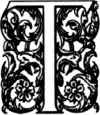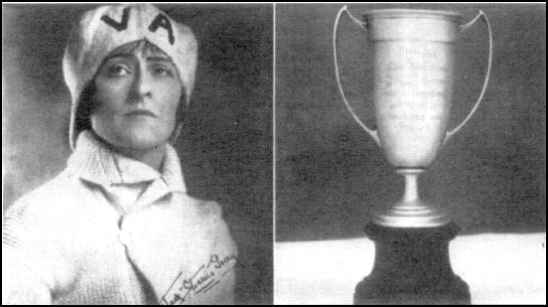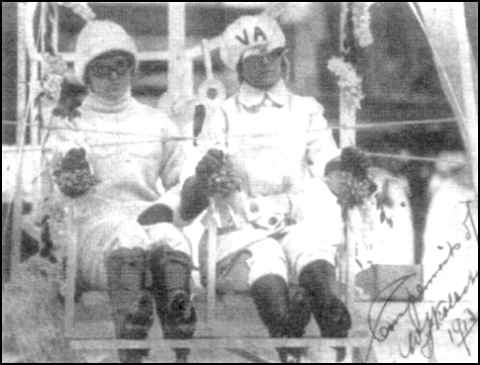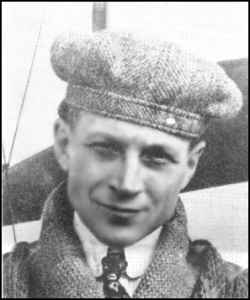
1882-1956 |
 |
|
"Jack" & George A. Gray "barnstorming" in their old plane "UP" in the pioneer days. Note arrow pointing to punctured wing where we
took a fence in preference to a freight train. This narrow escape occurred near Culpeper, Virginia in 1912. Official Newsletter of The Virginia Aeronautical Historical Society Courtesy of Norm Craybill |
|
History Project Report by: Norm Craybill |
|
"Jack" Stearns Gray is not a licensed pilot, but one of the Veteran Women Passenger Flyers of America; a "Flying Trooper" of "Barnstorming" Days, and the wife of George A. Gray, famous pioneer Wright aviator, who navigated the skies in the classic days of the wing-seat and the open engine--the days when flying was 85 per cent man and 15 per cent machine! Such is the story of "UP." A widespread interest has been shown in the book as is evidenced by the following letters which have been selected from a vast number received by Mrs. Gray. House of Representatives My Dear Mrs. Gray: I am interested to hear that you contemplate giving a narrative in book form of your experiences in aviation. It will have particular interest for me, in view of the fact that you are a native of the District I represent, and the first woman who made a flight in the State of Virginia. Added interest will be due to the fact that your career as a veteran passenger flyer has been marked by so much courage, and at the same time I am glad to add, but so much good fortune. Yours very sincerely R. WALTON MOORE Dear Mrs. "Jack" Stearns Gray: Congratulations on your efforts to get out a real book on the old aviation pioneers. In those days flying was pioneering and no mistake. Today, flying is the safe, comfortable and rapid way to travel. You should, and I know you do, value your early hops with George. You both made history. With every good wish and "happy landings." Most sincerely EARLE OVINGTON |
|
President (1930) The Early Birds First U. S. Air Mail Pilot Lieutenant-Commander U. S. N. R. |
|
Though the book is out of print, it is available through the Virginia State Inter-Library Loan program at
your local library.
MOUNTAIN CLIMBING |
 |
HE old saying is that "doubt precedes a certainty." We were certain that aviation would eventually come into its own, but at times that certainty was shadowed by discouragement and uphill climbing in more ways than one. About this period an enterprising advance manager (he was advanced considerable in a short time), walked off with $2,300 of our hard-earned "wampums." To this |
|
day we have never been able to locate this "get-away." It was a "tailspin" to trouble! Pandora's box wasn't in it. During these early days of flying we flew over my old home town of Culpeper, Virginia. One flight I remember particularly, over this El Dorado of magnificent scenery, replete with historical lore. We attempted to fly with poor test gasoline. The airplane could safely carry the aviator but not "excess baggage." I was determined to go up, because, as the motor hummed for a "get-away" the gate receipts had mounted to a considerable figure, and I did not wish to return the money. I was at the time desirous to help a very ill girl friend at Saranac Lake who had tuberculosis, and I was adamant on making that flight, even if it were only ten feet in the air so I could keep the price of admission legally. She needed immediate funds, and I justified the moral end of it by promising the crowd a longer and higher flight if the one on that day did not satisfy them. Gray finally consented, and said we'd try a "hop." That "hop" missed by a narrow margin being a fatal one. I was very foolish, but did not think so at the time. We rumbled off across the fair grounds, a much too short run for a safe take-off. We took this chance because it was the only practical place we could get an admission price paid, and as we rose in the air, the engine began to sputter and miss--then suddenly it got "sleeping sickness" and quit altogether. There we were, three hundred feet up, with no possible chance of making it back into the racetrack, a volplaning airplane--and "nowhere to go!" Gray had to think quick. I thought not at all. My mind was a perfect blank. Under us was a high fence, bordering the Southern Railway tracks, where fate decreed a freight train was slowly puffing along, adding not one whit to our already precarious predicament. We took the fence--posts and all. Neither one of us was injured, and only four dollars damage was done to the plane. I was terribly broken up in mind, if not in body, for I knew than I must return those gate receipts. The crowd would not let me. That was their kind. I, however, renewed my promise that I would make good on a flight over Culpeper just as soon as the plane could be repaired. Gray helped me keep my faith to my people by circling with me as passenger, the entire County of Culpeper, Virginia, on December 14, 1912--one week after our unfortunate mishap by the side of the Southern Railway. Two methods of travel, the airplane and the train, for once met on common ground, much to the grief of the former, but far from as disastrous as it might have been. In the "stick-and-string" contraptions of those early days, as the airplane has been called, it was a hair-raising escape. On this second attempt to fly at Culpeper, Virginia in 1912, we did not consider another "get-away" out of the racetrack, but towed the plane to a field adjoining, secured good test gasoline, and made a splendid take-off. After landing, amids a flurry of snow, I felt justified for keeping the gate receipts of the week before. We made no charge to see the successful flights that followed. |
 |
|
"Jack" Stearns Gray, author of "UP" and the silver cup presented her by her home town. Culpeper, Virginia, for being the first woman
from Virginia to fly as a passenger in an airplane from Virginia soil. Official Newsletter of The Virginia Aeronautical Historical Society Courtesy of Norm Craybill |
|
On that day I was presented a beautiful loving cup by the people of Culpeper, which I am proud to
pass down to my posterity. I also won two medals in this "flying business" from unofficial sources, one for flying in the Adirondacks with
Gray in 1912, and the other for building a replica of that airplane for a parade at the Ice Carnival at Saranac Lake, N. Y. in 1913.
Governor Mann of Virginia wrote me a letter of congratulations for being the first woman from Virginia to fly from Virginia soil. I truly
"tread the air" after that. I graciously invited the Governor to take an airplane ride with Gray, during my flights in Culpeper, Virginia in
1912, which he declined. I was not married to Gray at that time, but he was most generous with his plane. No fares were exacted from
me any more. |
 |
|
The airplane I built with the help of one man to enter in the Ice Carnival Parade in February 1913, at Saranac Lake, NY. I won fifth prize
with it in competition with sixty floats, but froze my feet for the honor. The violets on the levers are real. I am flaunting the "VA" on my
cap for my home state. Official Newsletter of The Virginia Aeronautical Historical Society Courtesy of Norm Craybill |
|
Therefore we did not stop off at Culpeper the autumn of 1913, after our marriage, as we pushed
southward, for the reason Gray had already made twenty-three flights over the town (which is fast becoming a city) and we felt sure
that Culpeper had become far ahead in "air-mindedness." So we secured a contract to fly in the isolated and mountainous section of
Virginia, where the hum of an airplane motor had never been heard. Our first stop was at Fincastle. It was in the heart of the Blue
Ridge. But their exploits at Fincastle is another story, told in the rest of the chapter. Look it up. After their barnstorming career, jack and George had three children, George, Jr., Newcombe, and Jacquelyn. If any reader iknows of them or their descendants, please get in touch with me. Perhaps they would be willing to exhibit the silver "Culpeper Cup" in the Virginia Aviation Museum, and also provide a home there for the dispay of the one remaining part of their Wright Model B - a part of a skid still in Jack's possession when she wrote in the book in 1931. Editor's Note: This article was reproduced in its entirety through the kind permission of the author, Norm Craybill, and the Virginia Aeronautical History Museum. It appeared in their official newsletter for January/February/March 2002, the Virginia Eagles, |
The Sailor Aviators: A Tale of the Men of Navy Patrol Bombing Squadron 21 of World War II A book by Donald H. Sweet. Editor's Note: You may learn more of Donald Sweet and his other fine books by clicking on: |
|
You may want to use the "Find" function on "Gray" to locate his name on the page. |
|
|
|
After you have finished with this page, I suggest that you sample some of the many other entries by clicking on "HOME" or on: |
|
by Ann Walko You will find a reference to George in this newsletter of the Ocean Park Historical Society. In addition, you will find references to several other pioneer aviators. To access the site, click on the title above. |
 |
ORVILLE'S AVIATORS Outstanding Alumni of the Wright Flying School, 1910-1916 John Carver Edwards Product Details Paperback: 200 pages; 9.9 x 6.9 x 0.7 inches Publisher: McFarland (May 13, 2009) List Price: $45.00 Used Price: $33.33 # ISBN-10: 0786442271 # ISBN-13: 978-0786442270 |
|
Product Description from Amazon.com The six pioneers profiled here were promising graduates of the Wright Brothers' School of Aviation, which flourished in Ohio from 1910 to 1916. These airmen fairly represent their 113 fellow alumni in their all-consuming love of flying. The pilots are Arthur L. Welsh, a Russian immigrant who rose to become Orville Wright's chief instructor; Howard Gill, heir to an international tea dynasty; Archibald Freeman, whose flour-bag bombing of Boston Harbor won him attention as an early exponent of the supremacy of air power; Grover Cleveland Bergdoll, whose promise as a pilot quickly soured; George A. Gray, whose marriage resulted in an extraordinary husband and wife exhibition team; and Howard Max Rinehart, aerial mercenary, international racing competitor, Wright test pilot, South American explorer, and co-owner of one of America's premier charter services. About the Author John Carver Edwards served as university archivist at the University of Georgia before retiring in 2000 as special projects archivist. He has authored dozens of historical articles and scores of book reviews. He is a book reviewer for Library Journal. He lives in Cleveland, Georgia. |
 |
|
On February 1st, 1956 the Early Birds lost a beloved member when George Gray took off for the Great Beyond. George was born in Blue Hill, Maine, September 23, 1878 and was educated at the Blue Hill Academy. He learned to fly at the Wright School of Aviation, Dayton, Ohio, in 1911, receiving private pilot certificate No. 142. He was the first to fly over the Adirondack Mountains and Lake Champlain, 1912, and made many demonstration and passenger-carrying flights over cities of the Eastern Seaboard area. Prior to the First World War he demstrated the effectiveness of bombing from his Wright "B" airplane over Camp Whitman and Fort Ethan Allan in New York State, and upon outbreak of the war was commissioned Captain, serving in France in 1917 and 1918. He remained in the Air Service until 1920, when he returned to civilian life and became a manufacturer's representative and consulting engineer with offices in Washington, D.C. In 1913 he married Edith Sterns of Culpepper , Va. She flew with him on several of his demonstration and inter-city flights, and chronicled their experience in her Book, "Up." published in 1931. George's name is inscribed in bronze on the memorial to Wilbur and Orville Wright in Dayton, where the pupils who learned to fly at that original Wright school are listed. George's remains were buried in Arlington Cemetery. A beautiful tribute of flowers from the Early Birds was placed on his brave. His mortal remains lie near the North Gate of that National Shrine, but his heart and his soul and his happy smile are his living heritage to us all, as he flies above us. |


|